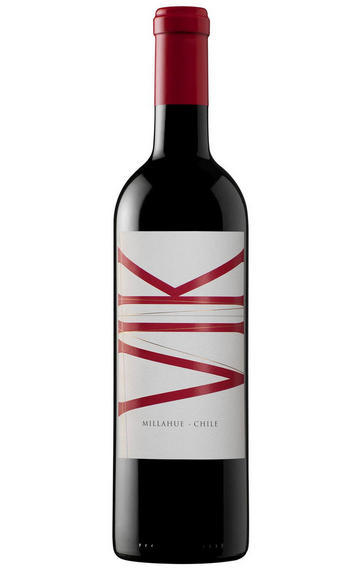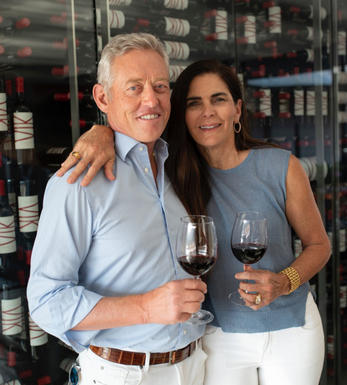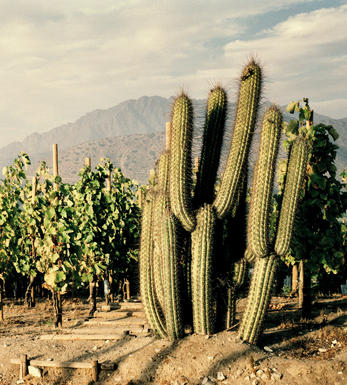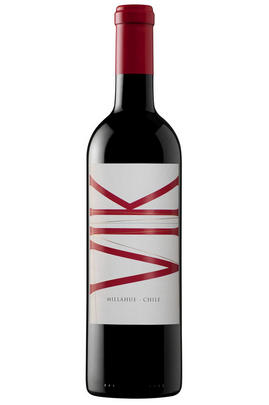
About this WINE

Viña VIK
Viña VIK is owned and run by Alex and Carrie VIK, who set out to make world-class wines from the Calchapoal Valley. After two years of scientific research, they settled on Millahue Valley. Amid the foothills of the Andes, this area is named “Lugar de Oro”, or “Golden Place” by the native Mapuche people. Designer by Chilean architect Smiljan Radic, the striking winery is set against the sweeping landscape Viña VIK calls home.
The 327 hectares are planted with Cabernet Sauvignon, Carménère, Merlot, Syrah and Cabernet Franc. VIK’s terroir comprises 12 individual valleys, each with its own distinctive microclimate. What unites these unique plots is the cooling effects of the Pacific coastal breezes, paired with winds that descend from the Andes.
They are perhaps best known for their eponymous flagship wine – VIK. This Bordeaux-style blend benefits from French oak-barrel ageing. Chief Winemaker Cristian Vallejo ensures a low-intervention approach, with grapes being harvested by hand and natural fermentation.

Colchagua Valley
The Colchagua Valley is one of Chile’s most renowned wine regions for producing high-quality red wines. The winemaking is deeply rooted in tradition and innovation, making it a dynamic and exciting region for wine enthusiasts.
The Mediterranean climate has warm, dry summers and cooling influences from the Pacific Ocean and the Andes Mountains. This climate and well-drained soils provide excellent conditions for growing grape varieties, with a particular focus on red grapes.
The valley is famous for its red Bordeaux varietals, such as Cabernet Sauvignon, Merlot, and Carménère. These grapes thrive in the region’s terroir and result in wines with rich flavours, ripe fruit characteristics, and well-integrated tannins. Carménère, in particular, has found a unique home in Colchagua Valley, as it was rediscovered here after being thought extinct for a long time.
Colchagua Valley Winemakers follow traditional and modern winemaking techniques. Many vineyards are hand-harvested to ensure the selection of only the best grapes. Using stainless steel tanks and oak barrels for ageing allows winemakers to craft wines with complexity and balance.
The region’s wineries range from small family-owned estates to large and well-known producers. Each winery strives to showcase the unique terroir of Colchagua Valley in its wines, resulting in a diverse range of styles and expressions.

Cabernet Sauvignon Blend
Cabernet Sauvignon lends itself particularly well in blends with Merlot. This is actually the archetypal Bordeaux blend, though in different proportions in the sub-regions and sometimes topped up with Cabernet Franc, Malbec, and Petit Verdot.
In the Médoc and Graves the percentage of Cabernet Sauvignon in the blend can range from 95% (Mouton-Rothschild) to as low as 40%. It is particularly suited to the dry, warm, free- draining, gravel-rich soils and is responsible for the redolent cassis characteristics as well as the depth of colour, tannic structure and pronounced acidity of Médoc wines. However 100% Cabernet Sauvignon wines can be slightly hollow-tasting in the middle palate and Merlot with its generous, fleshy fruit flavours acts as a perfect foil by filling in this cavity.
In St-Emilion and Pomerol, the blends are Merlot dominated as Cabernet Sauvignon can struggle to ripen there - when it is included, it adds structure and body to the wine. Sassicaia is the most famous Bordeaux blend in Italy and has spawned many imitations, whereby the blend is now firmly established in the New World and particularly in California and Australia.



Buying options
Add to wishlist
Description
The 2012 VIK somehow manages to be even more impressive than the exceptional 2011. A blend of 53% Cabernet Sauvignon, 35% Carménère, 6% Cabernet Franc, 4% Merlot and 2% Syrah, this wine has an intense, lifted nose dominated by blackcurrants. The palate however is beautifully fresh and succulent with layer upon layer of smooth, svelte fruit coming through. The tannins are in abundance, coating the mouth, but are pin-point fine resulting in a sense of suave sophistication. This is what ultra-premium, modern Chile is all about: exceptional concentration yet elegant with a juicy, refreshing character that brings harmony and balance to the endless finish. Drink 2018-2035+.
Catriona Felstead MW - Wine Buyer
wine at a glance
Delivery and quality guarantee